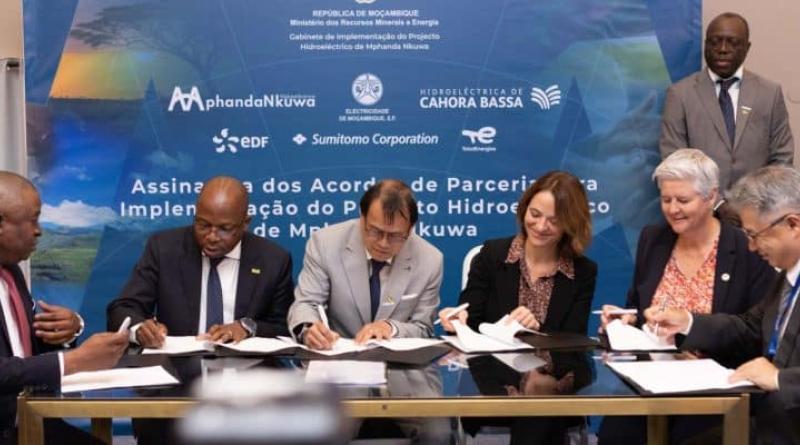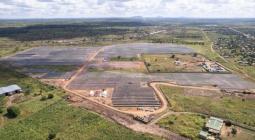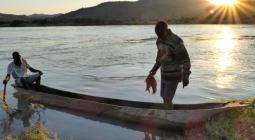MOZAMBIQUE: co-development agreements for the Mphanda Nkuwa mega-dam

In Mozambique, the consortium designated for the development of the Mphanda Nkuwa mega hydroelectric project signs the first agreements with the authorities. The hydroelectric development will require an investment of $5 billion.
News regarding the Mphanda Nkuwa hydroelectric project in Mozambique. The group of companies chosen for the construction of the dam concludes two agreements with the Mozambican authorities. TotalEnergies, Electricité de France (EDF) and Sumitomo Corporation sign a framework agreement with the Mozambican Ministry of Energy and Natural Resources (Mireme) and the public company Electricidade de Moçambique (EDM), foreshadowing “the future concession contract”.
The other agreement concerns joint development with the Gabinete de Implementação do Projecto Hidroeléctrico de Mphanda Nkuwa (GMNK), EDM and Hidroeléctrica de Cahora Bassa (HCB). It appears that the company ad hoc will be 40% owned by the French company EDF, 30% by its compatriot TotalEnergies and 30% by the Japanese investment company Sumitomo. The rest of the shares (30%) are divided between EDM and HCB.
New environmental and social impact studies
According to TotalEnergies, “the next stage of the project will consist of carrying out additional studies, the results of which will make it possible to define the best solutions in terms of environmental and social impact while guaranteeing the technical and financial viability of the project”. Overall, Mozambican authorities plan to build a hydroelectric dam on the Zambezi River in the Marara district. Its 1,500 MW power plant will be located 60 km downstream from the Cahora Bassa dam which has a capacity of 2,075 MW.
Read also- MOZAMBIQUE: equipped with a means of storage, the Cuamba solar park comes into service
The water reservoir will be located 70 km upstream from the town of Tete, the capital of the eponymous province. A transmission system comprising 1,300 km of 550 kV direct current high-voltage line will also be built between Cataxia and the Mozambican capital Maputo. According to TotalEnergies, the Mphanda Nkuwa hydroelectric development would increase the country's electricity production capacity by more than half (3,001 MW, according to Power Africa) and could power more than 3 million homes in Mozambique and the neighboring countries, “thus promoting socio-economic growth in southern Africa”.
The implementation of this megaproject will require an investment of $5 billion. Mphanda Nkuwa is already supported by the African Development Bank (AfDB) and the International Finance Corporation (IFC), the subsidiary of the World Bank group responsible for financing the private sector. In June 2023, the European Investment Bank (EIB) promised to contribute $500 million to the implementation of the project.
In Mozambique, the consortium designated for the development of the Mphanda Nkuwa mega hydroelectric project signs the first agreements with the authorities. The hydroelectric development will require an investment of $5 billion.
News regarding the Mphanda Nkuwa hydroelectric project in Mozambique. The group of companies chosen for the construction of the dam concludes two agreements with the Mozambican authorities. TotalEnergies, Electricité de France (EDF) and Sumitomo Corporation sign a framework agreement with the Mozambican Ministry of Energy and Natural Resources (Mireme) and the public company Electricidade de Moçambique (EDM), foreshadowing “the future concession contract”.
The other agreement concerns joint development with the Gabinete de Implementação do Projecto Hidroeléctrico de Mphanda Nkuwa (GMNK), EDM and Hidroeléctrica de Cahora Bassa (HCB). It appears that the company ad hoc will be 40% owned by the French company EDF, 30% by its compatriot TotalEnergies and 30% by the Japanese investment company Sumitomo. The rest of the shares (30%) are divided between EDM and HCB.
New environmental and social impact studies
According to TotalEnergies, “the next stage of the project will consist of carrying out additional studies, the results of which will make it possible to define the best solutions in terms of environmental and social impact while guaranteeing the technical and financial viability of the project”. Overall, Mozambican authorities plan to build a hydroelectric dam on the Zambezi River in the Marara district. Its 1,500 MW power plant will be located 60 km downstream from the Cahora Bassa dam which has a capacity of 2,075 MW.
The water reservoir will be located 70 km upstream from the town of Tete, the capital of the eponymous province. A transmission system comprising 1,300 km of 550 kV direct current high-voltage line will also be built between Cataxia and the Mozambican capital Maputo. According to TotalEnergies, the Mphanda Nkuwa hydroelectric development would increase the country's electricity production capacity by more than half (3,001 MW, according to Power Africa) and could power more than 3 million homes in Mozambique and the neighboring countries, “thus promoting socio-economic growth in southern Africa”.
The implementation of this megaproject will require an investment of $5 billion. Mphanda Nkuwa is already supported by the African Development Bank (AfDB) and the International Finance Corporation (IFC), the subsidiary of the World Bank group responsible for financing the private sector. In June 2023, the European Investment Bank (EIB) promised to contribute $500 million to the implementation of the project.





